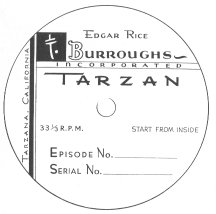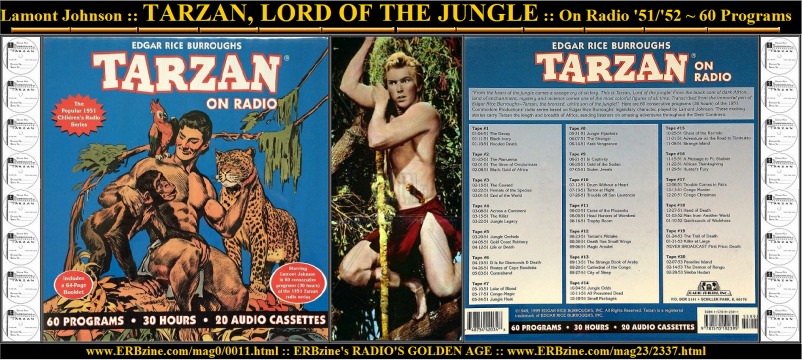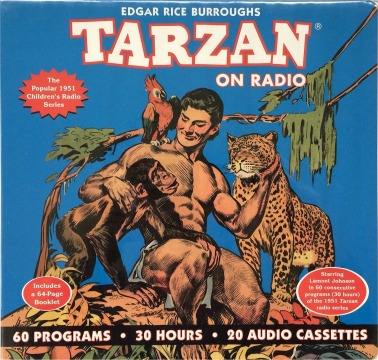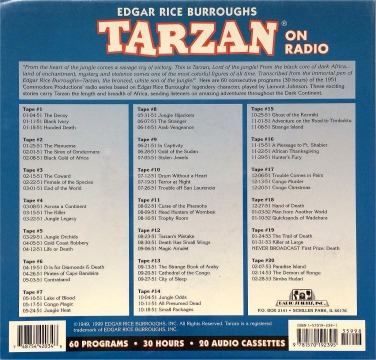
Official Edgar Rice Burroughs Tribute Site
Since 1996 ~ Over 15,000 Webpages in Archive
Volume 2337
Presents
TARZAN®
THE 1951 COMMODORE RADIO SERIES



"From the heart of the jungle comes a savage cry of victory. This is Tarzan, Lord of the Jungle! From the black core of dark Africa... land of enchantment, mystery and violence comes one of the most colorful figures of all time. Transcribed from the immortal pen of Edgar Rice Burroughs—Tarzan, the bronzed, white son of the jungle!” Thus Commodore Productions introduced their 1951 radio series based on Edgar Rice Burroughs' immortal character, played by Lamont Johnson. These exciting stories carry Tarzan the length and breadth of Africa and let listeners' imaginations send them on flights of fancy throughout the Dark Continent.

TARZAN ON RADIO
from
An Anecdotal Guide to Edgar Rice Burroughs' Tarzan On Radio
by Robert Barrett
Copyright Edgar Rice Burroughs
Edgar Rice Burroughs passed away on March 19, 1950. In the fall of 1950, Walter White, Jr. of Commodore Productions and Artists, Inc. contacted Cyril Ralph Rothmund, General Manager of Edgar Rice Burroughs, Inc., to discuss acquiring the national radio rights to Tarzan. On December 21, 1950, Rothmund and White signed a contract giving Commodore Productions the right to produce a series of half-hour Tarzan radio programs.Commodore Productions was basically a one-man show. His partner was his wife, Shirley Thomas, actress and co-producer -- to whom he was wed three times in three years! Commodore was a struggling concern until they acquired the rights to Hopalong Cassidy in 1948. Far from an instant success, Hopalong Cassidy languished until, for some unknown reason, it seemed to catch on. At about the same time, the old Hopalong Cassidy films were becoming popular on television. By 1950 William Boyd was at the centre of a storm of national popularity.
With the success of Hopalong Cassidy, Walter White, Jr. decided to create another radio adventure drama, The Clyde Beatty Show, starring Vic Perrin as Clyde Beatty and Eve McVeagh as his wife Harriet. This, too, was a success until it left radio for television. It was no wonder that the Whites considered Tarzan next to add to their growing roster of radio shows.
While all of the Commodore Tarzan programs are available, there is still much mystery surrounding the show. For one thing, very little is known about which parts the actors starring on the show played with the exception of Lamont Johnson, who played Tarzan. At various times, other cast members included: Jan Arven, Dick Beales, Bob Bruce, Larry Dobkins, Virginia Eller, Eddie Firestone Jr., Frank Gersten, Gloria Grant, Virginia Gregg, Gladys Holland, Charlie Lawton, Raymond Lawrence, Sidney Mason, Eve McVeagh, Shepard (Shep) Menken, Marvin Miller, Roland Morris, Donald Morrison, Jack Moyles, Jay Novello, Dan O'Herlihy, Jill Oppenheim, GeGe Pearson, Victor Rodman, Olan Soule, Theodore (Ted) von Eltz, Walter White III, David Wolfe and Barbara Jean Wong.
Lamont Johnson seems to have performed on radio from the mid-1940s through the early 1950s in a variety of roles on such shows as The Adventures of Frank Merriwell, Alias Jane Doe, Broadway is My Beat, Let's Pretend, The Modern Adventures of Casanova and Wendy Warren and the News. He went into television in the early 1950s where he acted and directed for several years. He eventually concentrated on film work, which he also began in the early 1950s as an actor, before becoming a respected director of such films as Kona Coast, One On One, A Gunfight, Lipstick, The Groundstar Conspiracy, The McKenzie Break and Spacehunter: Adventures in the Forbidden Zone.
No roster of the other players seems to exist. Walter White, Jr. produced them and they were written by Budd Lesser. It has been noted that at least three of the shows were scripted by others, "Volcano in the Sun" and "The Arena of Death" were scripted by Robert Schaeffer and Eric Freewall, and "Jungle Smoke" was scripted by David Chandler. Surviving letters from Budd Lesser in the files of Edgar Rice Burroughs, Inc. indicate that he authored all of the scripts, but this may have been because he was trying to enlist the assistance of ERB, Inc. in his suit for monies against Walter White, Jr.
The early 1930s Tarzan radio serials, those produced by American Radio Syndicate and Edgar Rice Burroughs, Inc. tried to portray the character of Tarzan as he was created by Burroughs. The half-hour Commodore shows seem to try and create a character based on Burroughs' Tarzan books and the MGM and RKO Tarzan films. Lamont Johnson portrays Tarzan as articulate rather than speaking in the "Me Tarzan, you Jane!" kind of gutturals from the movies; he notes that he was raised by the apes and prefers the jungle to civilization. The jungle background, as well as the cities and villages that are featured in the half hour shows, owe more to the movie than to Ed's stories.
From the heart of the jungle comes a savage cry of victory. This is Tarzan, Lord of the jungle! From the black core of dark Africa . . . land of enchantment, mystery, and violence comes one of the most colorful figures of all time. Transcribed from the immortal pen of Edgar Rice Burroughs -- Tarzan, the bronzed, white son of the jungle! And now in the very words of Mr. Burroughs:Whether he was consciously or unconsciously misleading his audience, Walter White, Jr. in his introduction each week, stated that these stories were "transcribed from the immortal pen of Edgar Rice Burroughs." In fact, none of these stories have any resemblance to any Tarzan stories written by Burroughs, with the exception of "Omen of the Emerald" and "The Arena of Death" (which are based on some elements from the novels Tarzan the Magnificent and Tarzan and the City of Gold.On this series of shows, Tarzan seems much too civilized, given to loquaciousness and, instead of living with his wife, Jane, on their vast African estate, he resides in the seacoast cabin built by his parents, who were set ashore by mutineers before his birth. The cabin seems to act as his office, in which he waits until being contacted by Captain Stanley Lawrence of the Governmental Police of some unnamed West African British colony or by one of the area's natives. In fact, Tarzan is more a Robin Hood of the jungle than the character portrayed in t eh novels. In Burroughs' novels, Tarzan would rather spend his time alone in the jungle, yet in the Commodore programs he feels a definite need for human companionship and seems to spend a lot of time with the Punya tribe. He seems more like a splendidly athletic man who can travel through the trees than one who spent all of his time in the company of apes until he ws twenty.
Also interesting is the fact that all of the natives in these shows call the animals by their ape names rather than calling them by the names in their tribal dialect. Having said that, the shows are really quite entertaining, mostly involving some mystery that Tarzan must solve, usually involving slave traders, uranium hunters, gold thieves, ivory poachers or cannibals. It's amazing that so much story could have been crowded into only a half-hour.
Tarzan debuted over Los Angeles radio station KHJ January 4, 1951. It replaced The Clyde Beatty Show, which moved to Mutual, airing three times a week at 5:30 pm. Tarzan was eventually broadcast over the entire Don Lee Mutual Broadcasting System, comprised of 45 stations in the Western States and was sponsored by Dr. Ross Dog and Cat Food. A total of 54 shows were broadcast before White was able to interest a national sponsor into purchasing the show, and it would be broadcast nationally.
On March 17, 1952, Walter White, Jr. signed a contract with Foote, Cone & Belding on behalf of their client, General Foods, who already had an agreement with CBC to broadcast the shows at 8:30 pm from their New York studios. CBC premiered the show March 22, 1952, and aired a total of 64 programs plus three repeats. Since Commodore produced a total of 75 shows, CBS failed to air eleven of them.
The Daily Variety, dated Thursday, January 8, 1953, noted that Tarzan was included in the Nielsen ratings at number 8, between Jack Benny, Amos 'n' Andy, Charlie McCarthy, Our Miss Brooks, Lux Radio Theatre, People Are Funny, Groucho Marx and The Philip Morris Playhouse, with Gene Autry coming in tenth. It seemed strange that General Foods notified Commodore on June 5, 1953 that it intended to take a summer hiatus of thirteen weeks and that the Tarzan show would go off the air with the June 27 broadcast. A hiatus that, for the Tarzan show, would prove to be permanent.
In the mid-1950s, Edgar Rice Burroughs, Inc. sold the rights for a Tarzan radio program to Artransa in Sydney, Australia. These were to be original fifteen-minutes-a-day serials developed from either original scripts or adapted from t he 1930s scripts furnished to them by ERB, Inc. These programs were also broadcast in New Zealand, as well as South Africa. However, Rothmund seemed to have overlooked the fact that he had signed the Australian rights for the Tarzan radio show to Walter White, Jr. As a result, Rothmund apologized to White and began turning Artransa's checks over to White. It is unknown just how many of these Australian radio shows were produced, but at least over 800.
After General Foods and CBS dropped the Tarzan radio show, Walter White, Jr. had little luck placing the show with another national sponsor or network. In the late 1950s and early 1960s, he was able to place the shows with KCOW in Alliance, Nebraska; KULA in Honolulu, Hawaii; three different stations in Canada and stations in Bermuda and Trinidad.
Commodore and Edgar Rice Burroughs, Inc. had a falling out in 1956 due to the prospect of a Tarzan television show. ERB, Inc. tried to find an excuse to nullify their contract with Commodore but were unsuccessful in the suit -- the court finding in favour of Commodore. Edgar Rice Burroughs, Inc. preferred that Sol Lesser produce a Tarzan television show since they were already involved in making the Tarzan films. Commodore then filed suit against Sol Lesser, who was trying to get a Tarzan television show produced. In this case, Commodore bit off more than they could chew and lost their case. Eventually, on November 18, 1963, Walter White, Jr. signed an agreement giving Edgar Rice Burroughs, Inc. all 75 of their tapes of the Tarzan programs and turning all rights to these shows to ERB, Inc.
 .
.
|
|
TARZAN RADIO THEATRE
|
|
Shows 1-20 |
Shows 21-40 |
Shows 41-60 |
THE PILOT EPISODE The Decoy 51.01.04 - (Pilot program) Baron, a wild animal broker, his daughter, Zyra, and Hammet, a white hunter, invade Tarzan's jungle. They have two goals: to capture elephants (which they plan to round up using female elephants as decoys) and Tarzan. Zyra is the decoy to capture Tarzan. The Lord of the Jungle falls for the beautiful girl, whom he refers to as his "White Goddess." His infatuation, however, is short lived when he discovers that beauty is only skin deep and narrowly escapes being caged. PLAY
|
Tarzan in Radio's Golden Age |
ERB of the Air |
|
Tarzan of the Air Radio Promo Handout |
Tarzan Radio Casts |
|
Tarzan and the Diamond of Ashair 39-Episode Radio Serial Summarized by Bill Hillman |
Tarzan and the Fires of Tohr Dell Comic & Radio Serial Comparision By Duane Adams |
|
Tarzan and the Fires of Tohr Radio Serial Episodes 1-18 Summarized by Duane Adams |
Tarzan and the Fires of Tohr Radio Serial Episodes 19-39 Summarized by Duane Adams |
DIAMOND OF ASHER ~ SERIAL SUMMARIES BY BILL HILLMAN
|
|
|
|
|
|
|
|
|
|
|
|
|
|
|
|
|
|
. | . |

ERBzine.com
Presents
The
Fantastic Worlds of Edgar Rice Burroughs
ERB
Companion Sites Created by Bill Hillman
![]()

![]()
BILL
HILLMAN
Visit
our thousands of other sites at:
BILL
and SUE-ON HILLMAN ECLECTIC STUDIO
ERB
Text, ERB Images and Tarzan® are ©Edgar Rice Burroughs, Inc.-
All Rights Reserved.
All
Original Work ©1996-2010/2019 by Bill Hillman and/or Contributing
Authors/Owners
No
part of this web site may be reproduced without permission from the respective
owners.